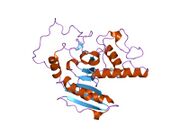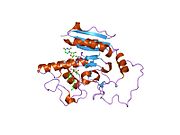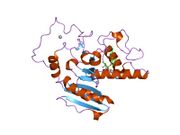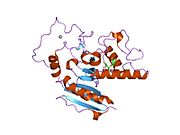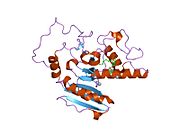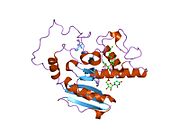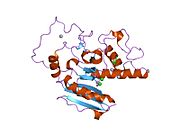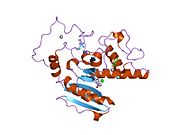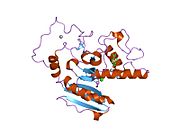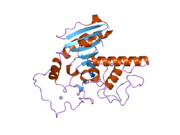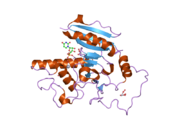Biology:ABO (gene)
 Generic protein structure example |
Histo-blood group ABO system transferase is an enzyme with glycosyltransferase activity, which is encoded by the ABO gene in humans.[1][2] It is ubiquitously expressed in many tissues and cell types.[3] ABO determines the ABO blood group of an individual by modifying the oligosaccharides on cell surface glycoproteins. Variations in the sequence of the protein between individuals determine the type of modification and the blood group. The ABO gene also contains one of 27 SNPs associated with increased risk of coronary artery disease.[4]
Alleles
The ABO gene resides on chromosome 9 at the band 9q34.2 and contains 7 exons.[2] The ABO locus encodes three alleles, that is, 3 variants of the same gene. One allele is derived from each parent.
The A allele produces α-1,3-N-acetylgalactosamine transferase (A-transferase), which catalyzes the transfer of GalNAc residues from the UDP-GalNAc donor nucleotide to the Gal residues of the acceptor H antigen, converting the H antigen into A antigen in A and AB individuals.
The B allele encodes α-1,3-galactosyl transferase (B-transferase), which catalyzes the transfer of Gal residues from the UDP-Gal donor nucleotide to the Gal residues of the acceptor H antigen, converting the H antigen into B antigen in B and AB individuals. Remarkably, the difference between the A and B glycosyltransferase enzymes is only four amino acids.[5]
The O allele lacks both enzymatic activities because of the frameshift caused by a deletion of guanine-258 in the gene which corresponds to a region near the N-terminus of the protein.[6] This results in a frameshift and thus of a truncated protein of only 117 amino acids.[5][7] The truncated protein is unable to modify oligosaccharides which end in fucose linked to galactose. Thus no A or B antigen is found in O individuals. This sugar combination is termed the H antigen. These antigens play an important role in the match of blood transfusion and organ transplantation.[5] Other minor alleles have been found for this gene.[2]
Common alleles
There are six common alleles in individuals of European descent. Nearly every living human's phenotype for the ABO gene is some combination of just these six alleles:[8][9]
- A
- A101 (A1)
- A201 (A2)
- B
- B101 (B1)
- O
- O01 (O1)
- O02 (O1v)
- O03 (O2)
Many rare variants of these alleles have been found in human populations around the world.
Clinical significance
In human cells, the ABO alleles and their encoded glycosyltransferases have been described in several oncologic conditions.[10] Using anti-GTA/GTB monoclonal antibodies, it was demonstrated that a loss of these enzymes was correlated to malignant bladder and oral epithelia.[11][12] Furthermore, the expression of ABO blood group antigens in normal human tissues is dependent upon the type of differentiation of the epithelium. In most human carcinomas, including oral carcinoma, a significant event as part of the underlying mechanism is decreased expression of the A and B antigens.[13] Several studies have observed that a relative down-regulation of GTA and GTB occurs in oral carcinomas in association with tumor development.[13][14] More recently, a genome wide association study (GWAS) has identified variants in the ABO locus associated with susceptibility to pancreatic cancer.[15][16]
Clinical marker
A multi-locus genetic risk score study based on a combination of 27 loci, including the ABO gene, identified individuals at increased risk for both incident and recurrent coronary artery disease events, as well as an enhanced clinical benefit from statin therapy. The study was based on a community cohort study (the Malmo Diet and Cancer study) and four additional randomized controlled trials of primary prevention cohorts (JUPITER and ASCOT) and secondary prevention cohorts (CARE and PROVE IT-TIMI 22).[4]
References
- ↑ "Localisation of the human ABO: Np-1: AK-1 linkage group by regional assignment of AK-1 to 9q34". Human Genetics 34 (1): 35–43. September 1976. doi:10.1007/BF00284432. PMID 184030.
- ↑ 2.0 2.1 2.2 "Entrez Gene: ABO ABO blood group (transferase A, alpha 1-3-N-acetylgalactosaminyltransferase; transferase B, alpha 1-3-galactosyltransferase)". https://www.ncbi.nlm.nih.gov/sites/entrez?Db=gene&Cmd=ShowDetailView&TermToSearch=28.
- ↑ "BioGPS - your Gene Portal System". http://biogps.org/#goto=genereport&id=28.
- ↑ 4.0 4.1 "Genetic risk, coronary heart disease events, and the clinical benefit of statin therapy: an analysis of primary and secondary prevention trials". Lancet 385 (9984): 2264–71. June 2015. doi:10.1016/S0140-6736(14)61730-X. PMID 25748612.
- ↑ 5.0 5.1 5.2 "Molecular genetic basis of the histo-blood group ABO system". Nature 345 (6272): 229–33. May 1990. doi:10.1038/345229a0. PMID 2333095. Bibcode: 1990Natur.345..229Y.
- ↑ "Rat encodes the paralogous gene equivalent of the human histo-blood group ABO gene. Association with antigen expression by overexpression of human ABO transferase". The Journal of Biological Chemistry 277 (48): 46463–9. November 2002. doi:10.1074/jbc.M206439200. PMID 12237302.
- ↑ "ABO - Histo-blood group ABO system transferase - Homo sapiens (Human) - ABO gene & protein" (in en). https://www.uniprot.org/uniprot/P16442.
- ↑ "The nature of diversity and diversification at the ABO locus". Blood 102 (8): 3035–42. October 2003. doi:10.1182/blood-2003-03-0955. PMID 12829588.
- ↑ "Extensive polymorphism of ABO blood group gene: three major lineages of the alleles for the common ABO phenotypes". Human Genetics 97 (6): 777–83. June 1996. doi:10.1007/BF02346189. PMID 8641696.
- ↑ "Translational mini-review series on Toll-like receptors: Toll-like receptor ligands as novel pharmaceuticals for allergic disorders". Clinical and Experimental Immunology 147 (2): 208–16. February 2007. doi:10.1111/j.1365-2249.2006.03296.x. PMID 17223960.
- ↑ "Bone marrow transplantation: 1982". British Medical Journal 285 (6351): 1296–8. November 1982. doi:10.1136/bmj.285.6351.1296. PMID 6812684.
- ↑ "Antigen structure and genetic basis of histo-blood groups A, B and O: their changes associated with human cancer". Biochimica et Biophysica Acta (BBA) - General Subjects 1473 (1): 247–66. December 1999. doi:10.1016/s0304-4165(99)00183-x. PMID 10580143.
- ↑ 13.0 13.1 "ABO blood-group antigens in oral cancer". Journal of Dental Research 84 (1): 21–8. January 2005. doi:10.1177/154405910508400103. PMID 15615870.
- ↑ "ABO blood group antigens in oral mucosa. What is new?". Journal of Oral Pathology & Medicine 31 (2): 65–70. February 2002. doi:10.1046/j.0904-2512.2001.00004.x. PMID 11896825.
- ↑ "Pancreatic Cancer Genetics". International Journal of Biological Sciences 12 (3): 314–25. 2016-01-01. doi:10.7150/ijbs.15001. PMID 26929738.
- ↑ "Genome-wide association study identifies variants in the ABO locus associated with susceptibility to pancreatic cancer". Nature Genetics 41 (9): 986–90. September 2009. doi:10.1038/ng.429. PMID 19648918.
Further reading
- "Human blood group glycosyltransferases. I. Purification of n-acetylgalactosaminyltransferase". The Journal of Biological Chemistry 253 (2): 377–9. January 1978. doi:10.1016/S0021-9258(17)38216-9. PMID 618875.
- "Biosynthesis of the blood group P antigen-like GalNAc beta 1-->3Gal beta 1-->4GlcNAc/Glc structure: a novel N-acetylgalactosaminyltransferase in human blood plasma". Journal of Biochemistry 112 (3): 389–95. September 1992. doi:10.1093/oxfordjournals.jbchem.a123910. PMID 1429528.
- "Animal histo-blood group ABO genes". Biochemical and Biophysical Research Communications 189 (1): 154–64. November 1992. doi:10.1016/0006-291X(92)91538-2. PMID 1449469.
- "Human histo-blood group A2 transferase coded by A2 allele, one of the A subtypes, is characterized by a single base deletion in the coding sequence, which results in an additional domain at the carboxyl terminal". Biochemical and Biophysical Research Communications 187 (1): 366–74. August 1992. doi:10.1016/S0006-291X(05)81502-5. PMID 1520322.
- "Isolation to homogeneity and partial characterization of a histo-blood group A defined Fuc alpha 1----2Gal alpha 1----3-N-acetylgalactosaminyltransferase from human lung tissue". The Journal of Biological Chemistry 265 (2): 1139–45. January 1990. doi:10.1016/S0021-9258(19)40169-5. PMID 2104827.
- "Cloning and characterization of DNA complementary to human UDP-GalNAc: Fuc alpha 1----2Gal alpha 1----3GalNAc transferase (histo-blood group A transferase) mRNA". The Journal of Biological Chemistry 265 (2): 1146–51. January 1990. doi:10.1016/S0021-9258(19)40170-1. PMID 2104828.
- "Sugar-nucleotide donor specificity of histo-blood group A and B transferases is based on amino acid substitutions". The Journal of Biological Chemistry 265 (31): 19257–62. November 1990. doi:10.1016/S0021-9258(17)30652-X. PMID 2121736.
- "An N-acetylgalactosaminyltransferase from human blood group A plasma. II. Kinetic and physicochemical properties". The Journal of Biological Chemistry 249 (11): 3448–52. June 1974. doi:10.1016/S0021-9258(19)42593-3. PMID 4831223.
- "An N-acetylgalactosaminyltransferase from human blood group A plasma. I. Purification and agarose binding properties". The Journal of Biological Chemistry 249 (11): 442–7. June 1974. doi:10.1016/S0021-9258(19)42592-1. PMID 4831233.
- "Uridine diphosphate-N-acetyl-D-galactosamine: D-galactose alpha-3-N-acetyl-D-galactosaminyltransferase, a product of the gene that determines blood type A in man". The Journal of Biological Chemistry 245 (6): 1484–90. March 1970. doi:10.1016/S0021-9258(18)63261-2. PMID 5442829.
- "Genetic mechanism of cis-AB inheritance. I. A case associated with unequal chromosomal crossing over". American Journal of Human Genetics 32 (3): 332–8. May 1980. PMID 6770676.
- "An Ael allele-specific nucleotide insertion at the blood group ABO locus and its detection using a sequence-specific polymerase chain reaction". Biochemical and Biophysical Research Communications 216 (2): 642–7. November 1995. doi:10.1006/bbrc.1995.2670. PMID 7488159.
- "Genomic cloning of the human histo-blood group ABO locus". Biochemical and Biophysical Research Communications 206 (1): 318–25. January 1995. doi:10.1006/bbrc.1995.1044. PMID 7598760.
- "Genomic organization of human histo-blood group ABO genes". Glycobiology 5 (1): 51–8. February 1995. doi:10.1093/glycob/5.1.51. PMID 7772867.
- "Genomic cloning of the human histo-blood group ABO locus". Biochemical and Biophysical Research Communications 211 (1): 347. June 1995. doi:10.1006/bbrc.1995.1817. PMID 7779106.
- "Molecular genetic analysis of the ABO blood group system: 2. cis-AB alleles". Vox Sanguinis 64 (2): 120–3. 1993. doi:10.1111/j.1423-0410.1993.tb02529.x. PMID 8456556.
- "Molecular genetic analysis of the ABO blood group system: 3. A(X) and B(A) alleles". Vox Sanguinis 64 (3): 171–4. 1993. doi:10.1111/j.1423-0410.1993.tb05157.x. PMID 8484250.
- "Molecular genetic analysis of variant phenotypes of the ABO blood group system". Blood 88 (7): 2732–7. October 1996. doi:10.1182/blood.V88.7.2732.bloodjournal8872732. PMID 8839869.
See also
External links
- Human ABO genome location and ABO gene details page in the UCSC Genome Browser.
- Overview of all the structural information available in the PDB for UniProt: P16442 (Histo-blood group ABO system transferase) at the PDBe-KB.
This article incorporates text from the United States National Library of Medicine, which is in the public domain.

